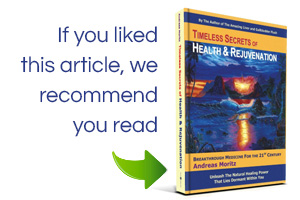By Andreas Moritz
Antibiotics have dominated the field of health for nearly 60 years. Known as a “magic bullet” treatment or “miracle drug,” antibiotics, meaning “against life,” can speedily destroy hordes of disease-causing bacteria. They are the most popular choice of the medical profession for stopping infections and relieving pain. At least one of every six prescriptions written each year is for an antibiotic drug. Antibiotics are so popular with doctors and patients because they provide relief very quickly.
Having grown up in a generation in which antibiotics are frequently prescribed for a stubborn case of cystitis, a sore throat or an itchy skin rash, we may readily accept that the “magic bullet” prescribed by the doctor is the best option to deal with such bacterial infections.
Although every medical student knows that viral infections (including colds and the flu) do not respond to antibiotics, millions of people who are afflicted with these ills still receive antibiotic prescriptions from their doctors. In 1983, more than 32 million Americans visited a doctor for treatment of the common cold and 95 percent of them went home with a prescription drug. More than half of them were unnecessarily given a prescription for an antibiotic.
Now, 25 years later, this trend has nearly doubled. Patients are rarely informed that even a single dose of a broad-spectrum antibiotic drug can severely damage the natural flora of the intestinal tract and the blood-forming red bone marrow for as many as four to five years. In the majority of cases, patients do not read the list of side effects written on the drug labels or direction sheets. They simply trust that their doctor knows what is best for them.
It is very disconcerting that many doctors don’t even know that penicillin, for example, won’t cure a cold or flu. Because of their very design, antibiotics impair the immune system and hence may sow the seeds for problems more serious than a cold in the future. Besides, a cold is not an illness, but rather the body’s first and best emergency response to rid itself of toxins. The virus only serves as a trigger for this cleansing response to occur. If you do “catch” a cold, consider it a blessing rather than a curse, and allow the body to heal itself.
Since most people prefer a quick-fix “cure” to a time-consuming one, antibiotics have become one of the most preferred forms of treatment today. However, it may take a minimum of 24 hours before infection-causing bacteria can be identified.
So the doctor, being pressed for time, tends to use a broad spectrum drug that can wipe out every microorganism it meets, including those that help protect us against disease. This may be justified in the rare event of a life-threatening infection, but certainly not for the vast majority of relatively mild infections. To make matters worse, in a large number of cases, specific antibiotics are administered to patients with symptoms of infection even before the lab sample has been analyzed. The chances that they will receive the wrong drug or take a drug for no reason at all are at least 50 percent.
If a man suffering from sinusitis leaves the doctor’s office empty-handed and “merely” receives advice on how to deal with his illness in a more natural way, he may think that his doctor hasn’t done his job or is irresponsible. The physician too, facing a viral infection, often prefers the comparatively “safe” option of an antibiotic to being blamed for not doing enough for the patient, particularly when the patient is a child. Otherwise, the doctor might even risk a lawsuit against him. Even though the probability that a child really requires antibiotics is as low as 1 in 100,000 cases, nearly 95 percent of all children taken to the doctor are given such drugs. In most of these cases, antibiotics are being misused “to please” overly worried mothers.
——————————
This is an excerpt from my book TIMELESS SECRETS OF HEALTH & REJUVENATION
——————————
You may share or republish this article provided you clearly mention the name of Andreas Moritz and paste a hyper link back to the web page





